Artificial intelligence is evolving at a rapid pace and changing the face of human resources (HR), making it smoother in all ways, including talent sourcing and employee engagement. Created with HR professionals, recruiters, business owners, and operations managers in mind, the tools take over the automated, tedious process, eliminate hiring bias, and allow data-driven decision-making. Efficiency and personalization are also important characteristics in hybrid and fast-paced work scenarios where scalability is required to allow them to keep up.
This is the list of the most efficient AI Tools for Human Resources that help to increase the strategic value of HR operations. The list of the top 10 AI tools applicable to HR management is chosen according to some critical parameters, such as highly advanced AI tools, integration simplicity, fairness, compliance level, scalability, and actionable analytics. These tools are also perfect to be use by teams that want to modernize their HR functions by using smart and trustworthy solutions.
Criteria for Selecting the Best AI Tools for Human Resources
- Use case fit: The tool must support your HR requirement, whether it is recruitment, performance management, engagement, or diversity employment. Targeted problems have exclusive solutions (e.g., Textio to find better job descriptions or Paradox to help an organization cover a lot of ground when recruiting).
- AI capabilities: Identify the solutions that have already demonstrated AI/ML functionality in the form of predictive analytics, intelligent matching, natural language processing (NLP), or chat automation. These should add real value beyond basic automation.
- Bias reduction and fairness: First of all, consider the ones with transparent algorithms and bias mitigation built in. Such instruments as Pymetrics and Eightfold AI are characterized by their fairness-sensitive design, which becomes a fundamental part of ensuring DEI-focused hiring.
- Ease of integration: Its functionality needs to fit well within the HR technology stack already in place, such as ATS, HRIS, email, or collaboration tools. This minimizes disruption and ensures seamless workflows.
- Scalability: Pick a platform that can expand along with your company. Some belong to small and medium businesses that have just started, whereas others are suited to enterprises seeking performance and hiring management on a massive level.
- User experience (UX): Intuitive interfaces for both recruiters and candidates/employees are essential. The UX that is not good enough results in fewer software adoptions and decreased ROI on the investment.
- Data security and compliance: Confirm that the software is GDPR/CCPA compliant and provides high-security usage of candidate/employee data. This is non-negotiable in HR tech.
- Reporting and analytics: Effective dashboards and live analytics assist HR leaders in making decisions. The tools are supposed to provide actionable information on hiring funnels, engagement, or performance.
- Support and training: Trustworthy customer service, manuals, and coaching can be the difference between proper implementation, more so when the platform is complex.
- Pricing and ROI: Compare price schemes based on per user, per recruiter, and enterprise license, and evaluate the product in light of the size of your team, the amount of hiring, and future efficiency improvement.
List of Top 10 AI Tools for Human Resources
1. HireVue
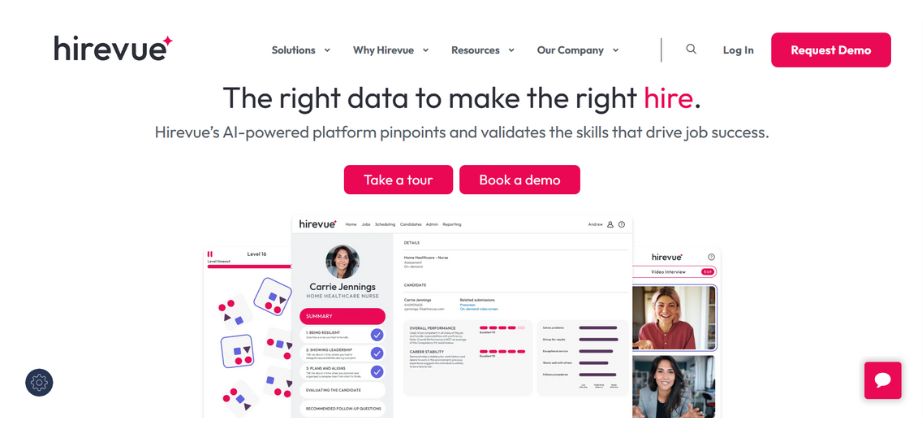
HireVue is an AI-powered recruiting tool that automates the preliminary process of hiring applicants through on-demand video interviewing and predictive analytics. It aids organizations in better evaluation of potential with its regular questions and machine-processed answers, enabling them to make a hiring decision using less time and bias. Manual creation of schedules and interviews is not required to assess competencies, communication skills, and personality traits by recruiters.
Its tools are especially valuable in high-volume hiring situations. HireVue also facilitates coding tests, as well as game-based assessment tests on technical positions. Although the efficiency presented by its AI could be seen as an advantage, the platform has received criticism for being fair and transparent in automated decisions, thus being limited to organizations with relatively developed compliance and evaluation processes.
Key features:
- AI-based video interview analysis
- Pre-employment assessments
- Structured interview guides
- Interview scheduling automation
- Real-time candidate scoring
Pros:
- Speeds up hiring by automating interviews
- Improves candidate evaluation consistency
Cons:
- May raise concerns about AI bias
- It can feel impersonal to candidates
Pricing: Custom pricing based on company size and features
Who should use it?
Mid to large-sized organizations are looking to scale and standardize their hiring processes.
2. Pymetric
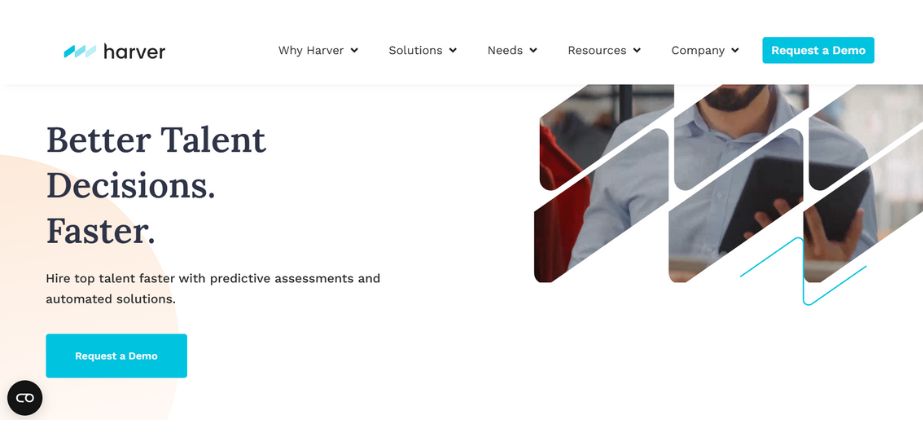
Pymetrics uses artificial intelligence and neuroscience-driven games to evaluate a candidate’s emotional and cognitive traits. Instead of using resumes whenever they want to find people, they come up with a behavioral profile and match them to jobs in which they will succeed. This strategy embraces diversity: one that pays much attention to potential rather than pedigree.
The platform can also give employers clues to eliminate bias and enhance the culture fit. Pymetrics is popular with companies that focus on inclusive employment and early career recruiting. It is interesting to candidates and has a special predictive power, but it is not conventional, maybe not in all user groups, and the functions that require specific technical qualifications.
Key features:
- Gamified candidate assessments
- Cognitive and emotional trait analysis
- Bias-reduction algorithms
- AI-driven career pathing
- Integration with ATS
Pros:
- Promotes unbiased and diverse hiring
- Engages candidates in a unique way
Cons:
- Only businesses that are receptive to unconventional evaluation techniques
- Requires candidate buy-in for games
Pricing: Custom pricing upon request
Who should use it?
Companies focused on potential-based hiring and building diverse teams.
3. Paradox (Olivia)

Paradox AI assistant, Olivia, uses conversation AI to automate the repetitive work of recruiting. Olivia speaks to candidates in real-time on chat, screens resumes, schedules interviews, and responds to frequently asked questions. It is also unified with leading Application Tracking systems and works across such channels as websites, SMS, and social media. This is a good tool in the setting of very large numbers of hires regularly, as it is in retail or in healthcare recruitment, where speed is of the essence.
Olivia can improve the candidate experience by providing applicants with instant feedback and the possibility of booking interviews. Although this is quite effective, its chatbot kind of mechanism has the potential to restrict highly delicate human communication, so it is more suitable to use it where the nature of the task is transactional, but not for hiring in-depth discussions.
Key features:
- AI chatbot for recruitment
- Interview scheduling automation
- Mobile-first experience
- Resume screening and filtering
- Candidate FAQs and updates
Pros:
- Greatly reduces recruiter workload
- Provides a fast, interactive candidate experience
Cons:
- Limited customization beyond conversational flows
- Works best for high-volume hiring
Pricing: Custom pricing
Who should use it?
Companies with high-volume hiring needs, such as retail, hospitality, or logistics.
4. Eightfold AI
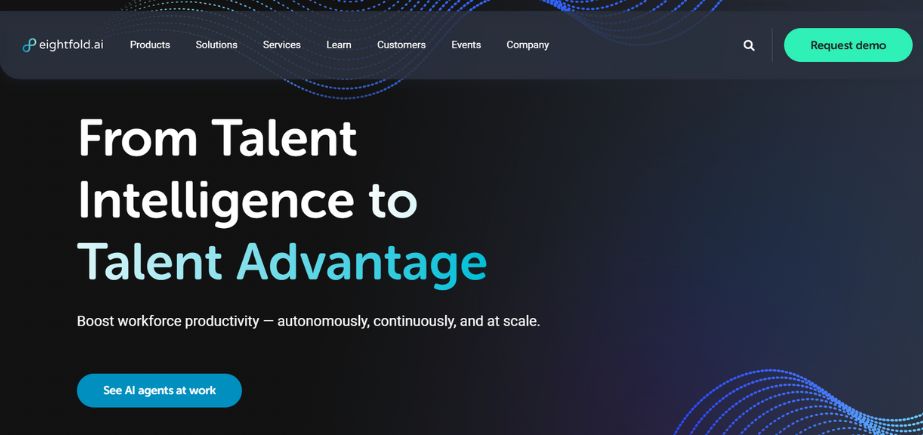
Eightfold AI is a talent AI tool that is based on deep learning to bring talent and match jobs to candidates and drive internal mobility and workforce planning. It uses billions of data points to evaluate potential even more than resumes and assist in minimizing bias and increasing long-term retention. Users can explore the demand analysis of skills, access talent, define skill gaps, predict workforce requirements, and reskill existing employees.
Eightfold is not only diverse and hiring-friendly but also can provide real-time analytics. It is most appropriate in terms of large-scale businesses that look to tap into data-driven talent management. Although effective, its use might be resource-demanding and complicated for small HR teams or firms that do not have an in-depth digital support system.
Key features:
- Talent matching and ranking
- AI-based diversity hiring
- Internal mobility tools
- Skills and career pathing
- Workforce planning insights
Pros:
- Helps uncover hidden talent internally
- Reduces bias in hiring decisions
Cons:
- Complex implementation for smaller teams
- Expensive for startups
Pricing: Enterprise pricing model; custom quote
Who should use it?
Enterprises and large organizations are seeking talent optimization and retention.
5. Fetcher
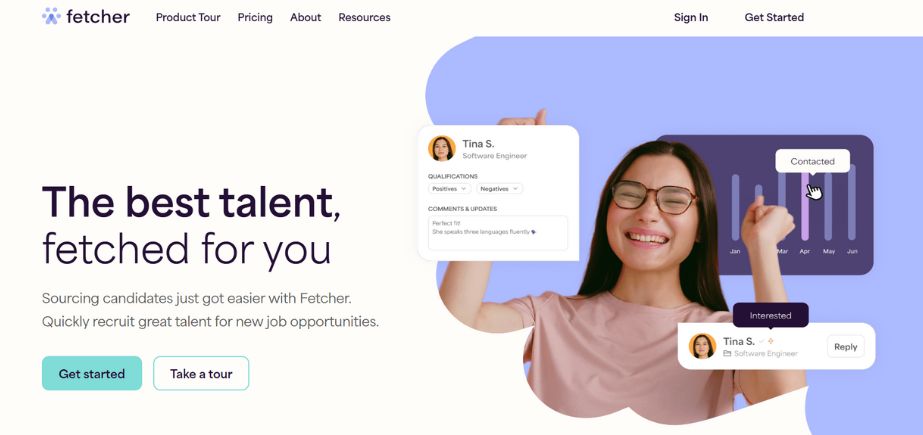
Fetcher is an AI- and human-curated job prospect sourcing and email outreach tool. It exports/is able to pull candidate data across platforms, enrich profiles, and automate the initial reach out, which saves recruiters time on top-of-funnel activity. Diversity filters, engagement tracking, and customizable sequences are also found in Fetcher.
It is a plug-and-play solution, and it is most comfortable to work in small to mid-sized teams, decreasing the dependence on job boards and manual search. Although Fetcher prevents faster sourcing, the automation sometimes overlooks minute details of the roles, meaning that human supervision is necessary. It is particularly useful to lean teams, who want to create quality pipelines without saturating their recruiters.
Key features:
- Automated candidate sourcing
- Email outreach campaigns
- Diversity-focused filters
- Talent pipeline analytics
- Calendar and ATS integration
Pros:
- Saves time on sourcing and outreach
- Improves diversity through smart filters
Cons:
- Less control over the candidate list compared to manual sourcing
- Email deliverability can vary
Pricing: Tiered plans starting from $500/month (approx.)
Who should use it?
Small to mid-sized businesses and recruitment agencies are focused on outbound hiring.
Suggested read: AI Tools for Social Media
6. X0PA AI

X0PA AI offers to use machine learning to investigate, pre-select, rank, and predict talent and hires, and then provide detailed reports outlining who is most likely to be the best fit, qualified, and likely to perform well in the job. It tries to automate the process of hiring, making it less biased and time-consuming through manual selection.
X0PA also assists in enabling employers to make objective decisions using tools such as intelligent shortlisting, skill scoring, and video interviews. It also supports diversity hiring through inclusive algorithms.
The platform will be a good fit and a better choice for academic institutions and government, and the same way for corporates who want equity in the massive or technical hiring. Nonetheless, smaller teams may require significant time to onboard and be customized.
Key features:
- AI-driven scoring and ranking
- Bias mitigation algorithms
- Applicant filtering
- Video interview integrations
- Predictive analytics dashboard
Pros:
- Increases hiring accuracy and objectivity
- Reduces manual screening time
Cons:
- May require training for optimal use
- Customization takes effort initially
Pricing: Available on request
Who should use it?
Government agencies, enterprises, and universities are seeking data-driven hiring.
7. Lattice
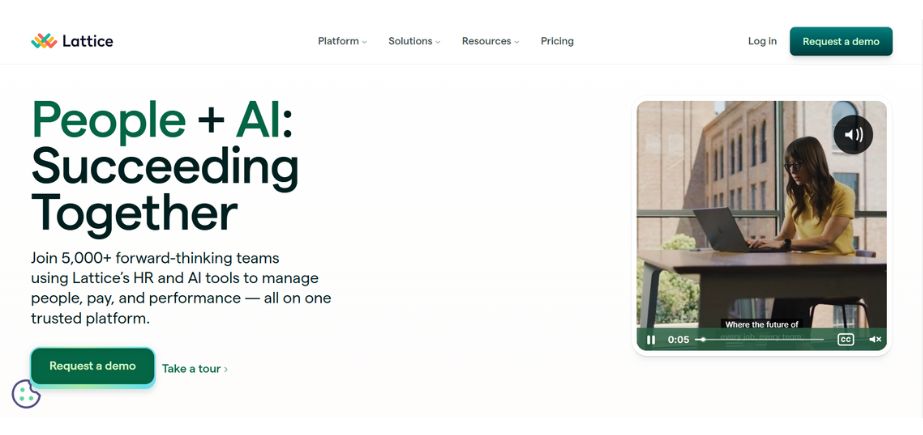
Lattice is a people success question that aids people in managing work performance, staff engagement, target establishment, and professional development through HR teams. With the help of AI-powered insights, it simplifies the feedback, performance reviews, and OKRs.
There is the possibility of tracking development, determining the areas of enhancement, and opening career discussions between employees and managers. Analytics on the platform allow HR to detect the areas of engagement challenges and streamline strategic decisions. Lattice promotes a culture that embraces frequent interaction of feedback, which improves retention and productivity to achieve its organizational goals.
Although quite potent, it can be more functional than what small teams would require, and it might take some training to adopt. It is best suited to medium to large companies that invest in the long-term development of employees and the operations of the people.
Key features:
- Goal setting and OKRs
- Performance reviews
- Employee engagement surveys
- AI-powered feedback suggestions
- Career development planning
Pros:
- Encourages employee development
- Useful analytics for HR decision-making
Cons:
- Less suitable for small companies
- Steep learning curve for full features
Pricing: Starts at $11/user/month
Who should use it?
Mid to large teams focused on continuous performance and employee engagement.
8. Recruitee
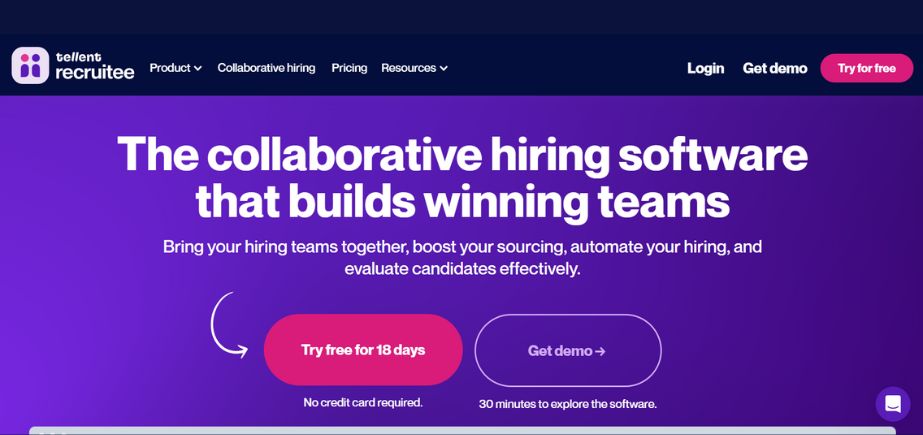
Recruitee is a collaborative hiring site that makes the process more straightforward with the help of innovative AI capabilities, such as fast parsing of resumes, automating job postings, and intelligent candidate filtration.
It enables efficient and transparent hiring through proper workflows that are organized, pipelines customizable, and overall communication centralized. Recruiters will be able to work with the hiring managers, update the status of the candidates, and produce reports.
Recruitee can also be connected with any ATS, calendar, and HR software. Small startups and medium-sized businesses looking for a user-friendly method and modern hiring practices will find it perfect. It is an intuitive tool, but it is not advanced in terms of predictive analytics that can be found in enterprise tools, so it would be a better fit for teams that grow fast and are not as large as a whole.
Key features:
- Resume parsing and AI matching
- Collaborative hiring workflows
- Job board integrations
- Custom hiring pipelines
- Reporting and analytics
Pros:
- Easy-to-use interface for hiring teams
- Strong automation for small teams
Cons:
- Fewer advanced AI features than enterprise tools
- Some integrations are add-ons.
Pricing: Starts at $199/month
Who should use it?
SMBs and startups need a streamlined, collaborative recruitment platform.
9. Textio
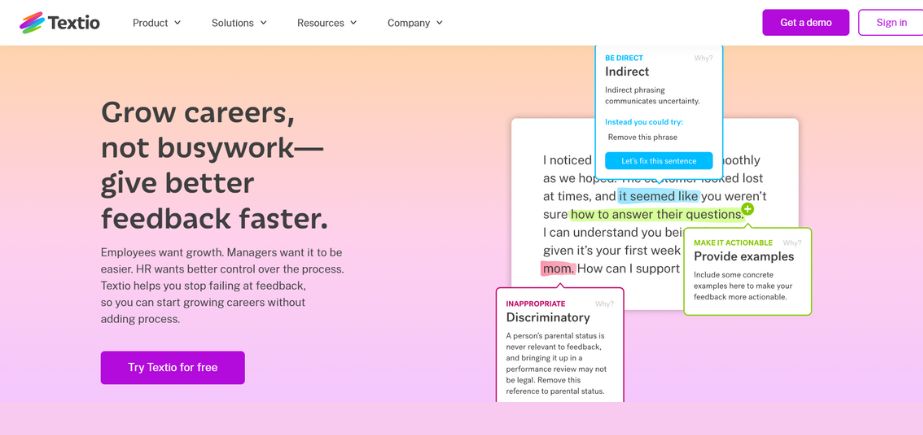
Textio is an augmented writing program that assists HR professionals in writing a more inclusive, bias-free, and interesting job description and internal messages. Textio finds gendered language, jargon, and tone with natural language processing and AI, and makes real-time suggestions on how to modify it.
It gives employment proponents some standards and diversity metrics to guarantee that their communications attract wider pools of job seekers. Textio improves employer branding and supports DEI goals.
Although it fails to facilitate a complete recruitment process, it significantly works to improves language impact. It works best with companies that are keen on horizontal hiring and communicating with employees, particularly in brand-centered businesses.
Key features:
- Bias and tone detection
- Real-time writing suggestions
- Gender-neutral language guidance
- Inclusive hiring metrics
- Benchmarking against industry language
Pros:
- Helps improve the employer brand and diversity
- Easy to use with immediate feedback
Cons:
- Focused only on writing, not full recruiting
- For small teams, subscription costs could be prohibitive.
Pricing: Custom pricing
Who should use it?
HR and DEI teams are looking to improve inclusive hiring communications.
10. Hiretual (now HireEZ)
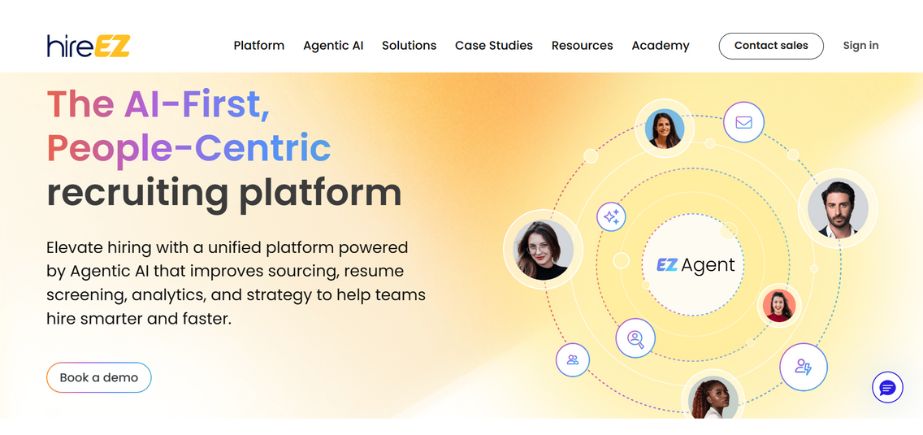
Hiretual, renamed to HireEZ, is a sourcing platform powered by AI that helps recruiters search and connect with passive candidates with more than 750 million profiles on the web. It employs AI in ranking candidates, profile enrichment, and follow-up sequences.
Boolean search, diverse sourcing, CRM connection, and live market introspection are all elements of the joystick. HireEZ excels at talent intelligence and building proactive pipelines.
It comes in handy in technology recruitment, healthcare, and niche areas where passive sourcing is paramount. Although it is feature-rich, the cost and learning curve may not be suitable for very small teams. Best for recruiters needing advanced sourcing capabilities.
Key features:
- AI candidate sourcing
- Email sequencing and outreach
- Talent market insights
- ATS and CRM integrations
- Candidate rediscovery
Pros:
- Excellent for passive talent discovery
- Saves time through intelligent automation
Cons:
- May require ramp-up time for new users
- Some features are locked in premium plans
Pricing: Starts at $169/month (individual recruiter plans)
Who should use it?
Tech recruiters, staffing agencies, and HR teams are sourcing niche or passive talent.
Suggested read: AI Tools for Email Writing
Comparison Between AI Tools for Human Resources
Here is a comparison table for the top AI tools for Human Resources, covering features, pricing, use cases, and official websites:
| Tool | Key Features | Pricing (If Available) | Ideal Use Cases | Website |
| HireVue | Video interviews, AI assessments, predictive analytics, coding tests | Custom pricing | High-volume hiring, structured interviews | hirevue.com |
| Pymetrics | Neuroscience-based games, behavioral profiling, and job matching | Custom pricing | Early-career hiring, DEI initiatives | pymetrics.ai |
| Paradox (Olivia) | Real-time screening, scheduling, AI chatbots, and applicant engagement | Custom pricing | Retail, healthcare, and hourly hiring | paradox.ai |
| Eightfold AI | Talent intelligence, skill matching, internal mobility, workforce analytics | Custom pricing | Enterprise recruiting, talent management | eightfold.ai |
| Fetcher | Automated sourcing, email sequences, diversity filters, analytics | Starts at $500/month (approx.) | Lean recruiting teams, passive candidate sourcing | fetcher.ai |
| X0PA AI | Intelligent matching, skill scoring, video interviews, and bias reduction | Custom pricing | Government, education, fair hiring | x0pa.com |
| Lattice | Performance reviews, OKRs, employee feedback, analytics | Starts at $11/user/month | People development, performance management | lattice.com |
| Recruitee | Collaborative hiring, pipeline management, automation, and reporting | Starts at $199/month | SMBs, growing teams | recruitee.com |
| Textio | Inclusive job descriptions, real-time writing suggestions, and DEI benchmarks | Custom pricing | Inclusive hiring, employer branding | textio.com |
| HireEZ | Talent sourcing, AI candidate matching, engagement automation, CRM features | Starts at $169/user/month | Tech hiring, healthcare, passive talent sourcing | hireez.com |
Conclusion
AI Tools for Human Resources are transforming the process of acquisition, management, and retention of talent in organizations. In the case of businesses with volume-based or hourly hiring, such as HireVue offers engaging hot features of excellent automation. Textio and Pymetrics are good, especially on fairness-oriented software, which is another great concern if the reduction of bias and inclusive hiring are your main priorities.
Eightfold AI offers in-depth analytics and internal mobility to plan talent intelligence and workforce on an enterprise level. Smaller companies and reserved budgets can achieve the best results with affordable but highly efficient solutions such as Fetcher or Recruitee. In the meantime, such tools as Lattice are perfect for organizations that intend to enhance performance management and staff development.
Hence, the suitable AI HR tool will ultimately be determined by the size of your business, your intended aim of meeting new hires, and your levels of digital maturity, yet when matched correctly, the platforms can achieve huge efficiency, impartiality, and strategic improvement in HR performance.
FAQs
1. How do human resource tools with AI work?
AI solutions within the HR context will automate and improve things such as candidate sourcing, resume screening, performance review, employee interaction, and communication. They will reduce manual labor, enhance the precision of hiring, individualize employee experience, and assist in the making of decisions based on data.
2. Will the AI tools help to decrease hiring bias?
It is true that most AI tools have fairness algorithms, which aim to reduce unconscious bias by relying more on skills, behavior, and predictive performance instead of subjective characteristics such as name, gender, or educational background. Inclusive hiring is specifically facilitated by such tools as Pymetrics or Eightfold AI.
3. Are these tools compatible with the available HR software?
The majority of current AI HR solutions are connected to applicant tracking systems (ATS), human resource information systems (HRIS), calendars, email, and productivity applications in order to automate processes and eliminate redundancies.
4. Can small businesses use AI HR tools?
Indeed, there are tools such as Fetcher and Recruitee that are especially suitable in small to mid-sized corporations because of the user-friendly interface and the low cost of the tools, as well as their billing format. Nevertheless, enterprise-level needs might be served well by more advanced platforms.
5. Is the data under the administration of AI HR tools safe?
The best AI HR technologies pay much attention to both information security and adherence to international laws such as GDPR and CCPA. One should select vendors with encrypted data storage and role-based access; their policies on obtaining, processing, and storing sensitive data about an employee or a candidate should be clear and transparent.
